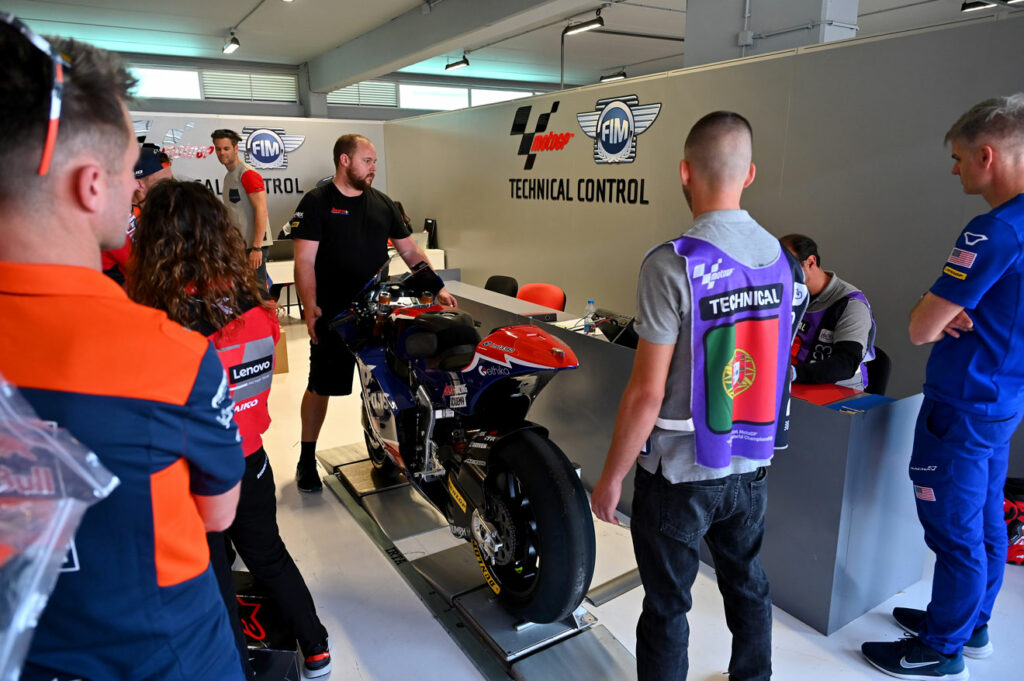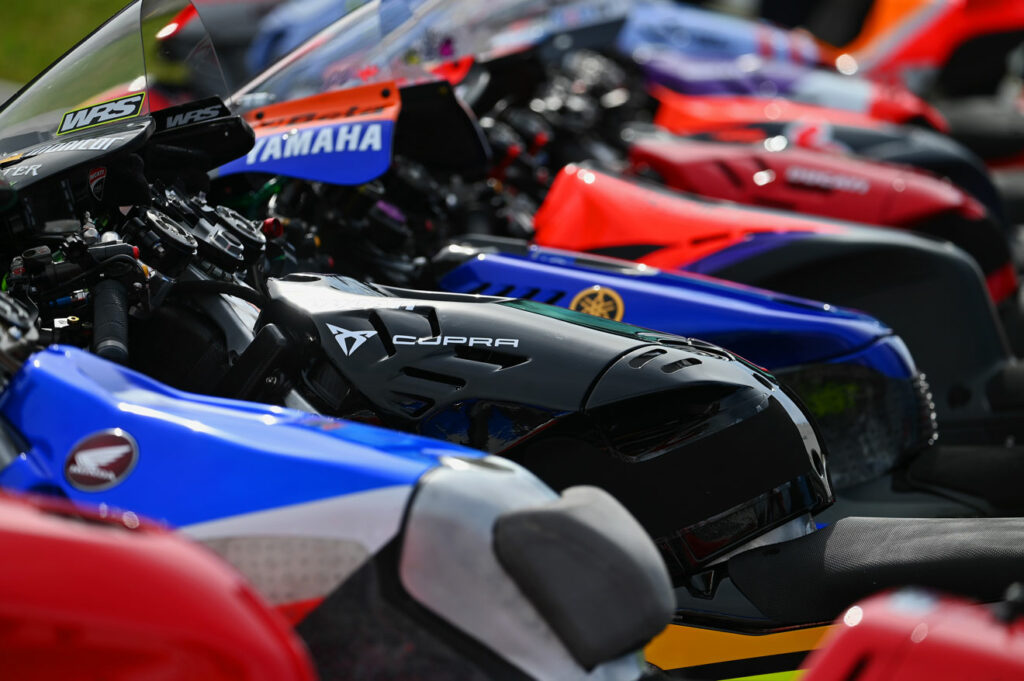
How important is a rider’s weight in MotoGP?
To what extent does a MotoGP rider’s weight influence their performance? Does it affect the bike’s behavior? Do lighter riders have a benefit over heavier ones? It’s a delicate question that’s been lingering around for quite a while now but which, for the moment, seems unlikely to give rise to any changes. Currently in MotoGP, the minimum weight limit only affects the motorcycle, whereas in Moto2 and Moto3, there’s a minimum combined rider-bike weight that was put in place to make bike performance fairer in this class of less powerful bikes, which heavier riders tend to weigh down.

Those larger and heavier riders argue that those who weigh less don’t weigh down their bike as much and are, therefore, at an advantage in certain moments, like during acceleration. On the other hand, you could also argue that taller riders have longer arms and legs that give them greater strength to handle the weight and great inertia of a MotoGP bike.
Who decides the minimum weight in MotoGP?
In order to introduce changes regarding a minimum weight, we’d have to go to the heads of technical regulation, who are the people that write the unanimously-approved MSMA (manufacturers association) rules, which are then validated by the body that manages and controls the MotoGP World Championship: the Grand Prix Commission. Members of this entity include representatives from FIM (International Motorcycling Federation), IRTA (association of teams), Dorna (commercial rights holder of the championship), and MSMA. In other words, the riders may complain all they want, but it’s up to the manufacturers, of their own accord or of that of the Grand Prix Commission, to propose a modification to this rule.

What do MotoGP riders usually weigh?
So it may be true that there is a weight difference between some riders of the current MotoGP grid, however these differences are not all that great.
As of today, according to data provided by Dorna, Pol Espargaró is the most lightweight of the class at 61 kilos. Alex Rins, on the other hand, is the heaviest, weighing 72 kilos. The tallest rider is Luca Marini at 1.84 m (6 ft.) and the shortest on the grid is Jorge Martín, who at 1.68 m (5 ft. 6 in.), is 16 cm (6 in.) shorter than Marini.

There may be some difference in height, but weight is a bit more uniform. For that reason, its impact on bike performance shouldn’t be very excessive this season. This may be why, despite complaints from some riders, the MotoGP class has not implemented a combined bike-rider weight limit.
What are current MotoGP weight averages?
In the 90s, there was a growing tendency of younger 125 cc class racers, which meant increasingly lighter and smaller riders. Since there was no age limit in the class back then, the championship became a motley mix of teens and veterans, with the former having an advantage in terms of weight.
Dadas las limitaciones técnicas de las motos de 125 c.c., cuyo peso mínimo era de 70 kilos, la diferencia de peso entre los pilotos influía en las prestaciones de las motos. Así, en 1996, se introdujo por primera vez el peso mínimo conjunto moto-piloto, estableciéndose en 130 kilos. Independientemente de ello, la moto se pesaba de manera independiente y debía tener un peso mínimo de 70 kilos.
For many young and slight riders, such as the thin Marc Márquez who debuted in the World Championship in 2008 at just 15 and weighing very little, that meant racing with a weighed down bike in order to meet the weight minimum, a problem which currently slows down Ana Carrasco in the Moto3 class.

This combined weight was gradually adjusted to 136 kilos in 2011, the last year that the 125 cc class competed. After 2012, the Moto3 class was put in place with a much higher combined minimum weight of 148 kilos, which in 2018 was raised to 152, where it still stands today. This rule was not applied to the Moto2 class until 2015 and was set at 215 kilos, to later be raised in 2018 to 217 kilos, the weight regulation that still applies today.
How much should a MotoGP bike weigh?
A combined weight minimum has never been established in the MotoGP or 500 cc categories. However, throughout the championship’s history, the weight of the bike has varied over time. In the 90s, the minimum weight of 500 cc bikes was around 130 kilos. Some manufacturers like Honda and Aprilia had a minimum weight closer to 116 kilos given their lower-performing twin-cylinder engines.

When MotoGP entered the scene, this same criteria was applied considering the different engine configurations that existed. In 2002, there were three, four, and five-cylinder engines, and on top of that, until 2005 the 500 cc bikes were still racing. They maintained their weight minimums from the 90s to compensate for the power and performance differences with a lower weight.
That first year of MotoGP, there were 29 kilos of difference between the lightest and heaviest bike.
- The Proton KR3, a 500 cc three-cylinder bike, weighed 116 kilos
- The Honda NSR 500 and Yamaha YZR 500, 131 kilos.
- The Aprilia RS3, a MotoGP three-cylinder, 135 kilos.
- The remaining MotoGP bikes, the Honda RC211V with its V-5 engine, as well as the Suzuki GSV-R with a V-4 engine, and the Yamaha YZR M1, with an inline-four engine, all weighed 145 kilos.
Despite their very distinct configurations and notable power differences, they all lived in harmony. Since 2006, the two-stroke engines have been prohibited and the weight minimum of bikes was very noticeably raised:
- The three-cylinders now weighed 140.5 kilos.
- The four-cylinders, 148 kilos.
- The five-cylinders, 155.5 kilos.
The next year, the engine displacement was reduced from 990 cc to 800 cc, and once the manufacturers opted for four-cylinder engines, the minimum weight was raised to 150 kilos in 2011.
In 2012, when current regulations were put in place, the maximum displacement was raised to 1000 cc and the minimum weight to 157 kilos, although the following year the weight was upped to 160 kilos. It wasn’t until 2016 that we returned to the original figure that is still the minimum weight in the premier class.

Actually, technical regulations allow manufacturers to build bikes with an 800 cc displacement and a minimum weight of 150 kilos, but so far, no one has attempted it, despite the advantage they would gain with an extra 7 kilos of weight difference. From a technical point of view, a lighter combined weight would not compensate for the performance variation between an 800 cc and a 1000 cc.


 Join Us
Join Us  Join Us
Join Us